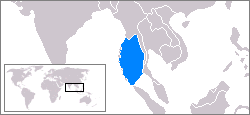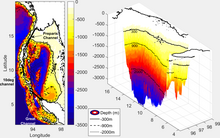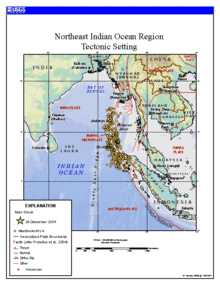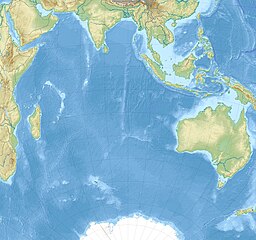Andaman Sea
| Andaman Sea | |
|---|---|
| Burma Sea | |
 Location of Andaman Sea in the Indian Ocean | |
| Coordinates | 10°N 96°E / 10°N 96°E |
| Type | Sea |
| Basin countries |
|
| Max. length | 1,202 km (747 mi) |
| Max. width | 647 km (402 mi) |
| Surface area | 797,000 km2 (307,700 sq mi) |
| Average depth | 1,096 m (3,596 ft) |
| Max. depth | 4,198 m (13,773 ft) |
| Water volume | 660,000 km3 (158,000 cu mi) |
| References | [1][2][3] |
| Andaman Sea | |
|---|---|
| Burmese name | |
Hindi | अंडमान सागर |
The Andaman Sea (historically also known as the Burma Sea)
Traditionally, the sea has been used for fishery and transportation of goods between the coastal countries and its coral reefs and islands are popular tourist destinations. The fishery and tourist infrastructure was severely damaged by the December 2004 Indian Ocean earthquake and tsunami.
Geography
Location
The Andaman Sea, which extends over 92°E to 100°E and 4°N to 20°N, occupies a very significant position in the Indian Ocean, yet remained unexplored for a long period. To the south of Myanmar, west of Thailand, and north of Indonesia, this sea is separated from the Bay of Bengal by the Andaman and Nicobar Islands and an associated chain of sea mounts along the Indo-Burmese plate boundary. The Strait of Malacca (between the Malay Peninsula and Sumatra) forms the southern exitway of the basin, which is 3 kilometres (1.9 mi) wide and 37 metres (121 ft) deep.
Extent
The International Hydrographic Organization defines the limits of the "Andaman or Burma Sea" as follows:[4]: p.21
On the Southwest. A line running from "
Poeloe Bras (Breuëh) and on through the Western Islands of the NicobarGroup to Sandy Point in Little Andaman Island, in such a way that all the narrow waters appertain to the Burma Sea.On the Northwest. The Eastern limit of the Bay of Bengal [A line running from Cape Negrais (16°03'N) in Burma [Myanmar] through the larger islands of the Andaman group, in such a way that all the narrow waters between the islands lie to the Eastward of the line and are excluded from the Bay of Bengal, as far as a point in Little Andaman Island in latitude 10°48'N, longitude 92°24'E].
On the Southeast. A line joining Lem Voalan (7°47'N) in Siam [Thailand], and Pedropunt (5°40'N) in Sumatra.
Oedjong means "
Exclusive economic zone
| Number | Country | Area (Km2) |
|---|---|---|
| 1 | 659,590 | |
| 2 | 511,389 | |
| 3 | 118,714 | |
| 4 | 76,500 | |
| Total | Andaman Sea | - |
Geology

The northern and eastern side of the basin is shallow, as the


The northern and eastern parts are shallower than 180 meters (590 feet) due to the silt deposited by the Irrawaddy River. This major river flows into the sea from the north through Myanmar. The western and central areas are 900–3,000 meters (3,000–9,800 ft) deep. Less than 5% of the sea is deeper than 3,000 meters (9,800 feet), and in a system of submarine valleys east of the Andaman-Nicobar Ridge, the depth exceeds 4,000 meters (13,000 feet).[2] The sea floor is covered with pebbles, gravel, and sand.[1]
The western boundary of the Andaman Sea is marked by volcanic islands and sea mounts, with straits or passages of variable depths that control the entry and exit of water to the
Ocean floor tectonics

Running in a rough north–south line on the seabed of the Andaman Sea is the boundary between two
The boundary between two major tectonic plates results in high seismic activity in the region (see List of earthquakes in Indonesia). Numerous earthquakes have been recorded, and at least six, in 1797, 1833, 1861, 2004, 2005, and 2007, had a magnitude of 8.4 or higher. On 26 December 2004, a large portion of the boundary between the Burma plate and the Indo-Australian plate slipped, causing the 2004 Indian Ocean earthquake. This megathrust earthquake had a magnitude of 9.3. Between 1,300 and 1,600 kilometres (810 and 990 mi) of the boundary underwent thrust faulting and shifted by about 20 metres (66 ft), with the sea floor being uplifted several meters.[9] This rise in the sea floor generated a massive tsunami with an estimated height of 28 meters (92 feet)[10] that killed approximately 280,000 people along the coast of the Indian Ocean.[11] The initial quake was followed by a series of aftershocks along the arc of the Andaman and Nicobar Islands. The entire event severely damaged the fishing infrastructure.[12]: 40–42
Volcanic activity

Within the sea, to the east of the main Great Andaman island group, lies Barren Island, the only currently active volcano associated with the Indian subcontinent. This island volcano is 3 km (2 mi) in diameter and rises 354 metres (1,161 ft) above sea level. Its recent activity resumed in 1991 after a quiet period of almost 200 years.[13] It is caused by the ongoing subduction of the India plate beneath the Andaman island arc, which forces magma to rise in this location of the Burma plate. The last eruption started on 13 May 2008 and continues.[14] The volcanic island of Narcondam, which lies further north, was also formed by this process. No records exist of its activity.[15]
Sediments to the Sea
Collectively, the modern Ayeyarwady (Irrawaddy) and Thanlwin (Salween) rivers deliver >600 Mt/yr of sediment to the sea.[16] Most recent studies show: 1) There is little modern sediment accumulating on the shelf immediately off the Ayeyarwady River mouths. In contrast, a major mud wedge with a distal depocenter, up to 60 metres (200 ft) in thickness, has been deposited seaward in the Gulf of Martaban, extending to approximately 130 metres (430 ft) water depth into the Martaban Depression. Further, 2) There is no evidence showing that modern sediment has accumulated or is transported into the Martaban Canyon; 3) a mud drape/blanket is wrapping around the narrow western Myanmar Shelf in the eastern Bay of Bengal. The thickness of the mud deposit is up to 20 metres (66 ft) nearshore and gradually thins to the slope at −300 metres (−980 ft) water depth, and likely escapes into the deep Andaman Trench; 4) The estimated total amount of Holocene sediments deposited offshore is approximately 1,290 by 109 tonnes (1,270 by 107 long tons; 1,422 by 120 short tons). If we assume this has mainly accumulated since the middle Holocene highstand (~6000 yr BP) like other major deltas, the historical annual mean depositional flux on the shelf would be 215 megatonnes (212,000,000 long tons; 237,000,000 short tons) per year, which is equivalent to ~35% of the modern Ayeyarwady-Thanlwin rivers derived sediments; 5) Unlike other large river systems in Asia, such as the Yangtze and Mekong, this study indicates a bi-directional transport and depositional pattern controlled by the local currents that are influenced by tides, and seasonally varying monsoons winds and waves.[16]
Climate

The climate of the Andaman Sea is determined by the monsoons of southeast Asia,[3] as the prevailing winds reverse with the start of either season. The region experiences north-easterlies with an average windspeed of 5 m/s (18 km/h) from November to February. During these months, the western part of the domain experiences maximum wind intensity. It weakens by March–April and reverses to strong south-westerlies from May to September, with mean wind speeds touching 8 m/s (29 km/h) in June, July, and August, distributed near-uniformly over the entire basin. Wind speeds plummet by October and switch back to north-easterlies from November.

Air temperature is stable over the year at 26 °C (79 °F) in February and 27 °C (81 °F) in August. Precipitation is as high as 3,000 millimetres (120 in)/year and mostly occurs in summer. Sea currents are south-easterly and easterly in winter and south-westerly and westerly in summer. The average surface water temperature is 26–28 °C (79–82 °F) in February and 29 °C (84 °F) in May. The water temperature is constant at 4.8 °C (40.6 °F) at the depths of 1,600 metres (5,200 ft) and below. Salinity is 31.5–32.5‰ (parts per thousand) in summer and 30.0–33.0‰ in winter in the southern part. In the northern part, it decreases to 20–25‰ due to the inflow of freshwater from the Irrawaddy River. Tides are semidiurnal with an amplitude of up to 7.2 metres (24 ft).[1]
The effect of wind stress on the ocean surface can be explained by wind stress curl. The net divergence of water in the ocean mixed layer results in Ekman pumping.[3] The contrast between the two seasons elicits a very strong negative pumping velocity of more than 5 m (16 ft) per day along the north coast of Indonesia from May to September (shown here, June). This may signify coastal downwelling in the summer. It is also observed that the region develops a weak but positive pumping velocity of less than 3 m (9.8 ft) per day at the mouth of GC in winter (here, December).
Current and wave fluid dynamics

Generally, currents are found to be stronger in the south than any other part of the basin.[3] An intense surface outflux through GC, of the order of 40 cm/s (16 in/s), occurs during summers and winters. While this flow is directed westwards in winter, it is southwards along the west coast of Indonesia in summer. On the other hand, the TDC has strong surface influx in summer, which weakens by October. This is followed by a sturdy outflux in winter, which wanes by the month of April. Although the surface flow through PC is generally inward during summer monsoon, the preceding and succeeding months experience outflow (strong outflow in October, but weak outflow in April). During April and October, when the effects of local winds are minimal, Andaman Sea experiences the intensification of meridional surface currents in the poleward direction along the continental slope on the eastern side of the basin. This is characteristic of the propagation of Kelvin Waves.[3][17]

It is observed that the water level rises in the basin between April and November with the maximum rate of piling up of water during April and October (marked by the steep slope of the curve).[3] The rise in sea surface height (SSH) is attributed to rainfall, fresh water influx from rivers, and inflow of water through the three major straits. The first two of these are quantifiable and are hence expressed in volumes of water for comparison. From this, the expected influx through the straits (= SSH anomaly – Rainfall – River Influx) could be deduced. A possible fourth factor, evaporative losses, is negligible in comparison. (Previous studies[18] show that the annual mean freshwater gain (precipitation minus evaporation) of the Andaman Sea is 120 centimetres (47 in) per year.) It is found that the SSH of the basin is primarily determined by the transport of water through the straits. The contributions from rainfall and rivers become substantial only during summer. Hence, a net inward flow occurs through the straits between April and November, followed by a net outward transport until March.[17]


The basin has a very high rate of transport of water through the straits in April and October. This is a period of equatorial
Ecology
Flora

The coastal areas of the Andaman Sea are characterized by
Other important sources of nutrients in the Andaman Sea are seagrass and the mud bottoms of lagoons and coastal areas. They also create a habitat or temporal shelter for many burrowing and benthic organisms. Many aquatic species migrate from and to seagrass either daily or at certain stages of their life cycle. The human activities which damage seagrass beds include waste water discharge from coastal industry, shrimp farms and other forms of coastal development, as well as trawling and the use of push nets and dragnets. The 2004 tsunami affected 3.5% of seagrass areas along the Andaman Sea via siltation and sand sedimentation and 1.5% suffered total habitat loss.[12]: 7
Fauna



The sea waters along the
Coral reefs are estimated to occupy 73,364
Human activities
The sea has long been used for fishing and transportation of goods between the coastal countries.
Fishing
Thailand alone harvested about 943,000 t (2.079×109 lb) of fish in 2005 and about 710,000 t (1.57×109 lb) in 2000.
Production numbers are significantly smaller for Malaysia and are comparable, or higher, for Myanmar.[22] Competition for fish resulted in numerous conflicts between Myanmar and Thailand. In 1998 and 1999, they resulted in fatalities on both sides and nearly escalated into a military conflict. In both cases, the Thai navy intervened when Burmese vessels tried to intercept Thai fishing boats in the contested sea areas, and Thai fighter aircraft were thought to be deployed by the National Security Council. Thai fishing boats were also frequently confronted by the Malaysian navy to the extent that the Thai government had to caution its own fishers against fishing without license in foreign waters.[23]
The 2004 marine production in Thailand was composed of:
Mineral resources
The sea's mineral resources include
Tourism
The Andaman Sea, particularly the western coast of the
See also
- Countries of the Bay of Bengal
- History of Indian influence on Southeast Asia
- Kra Isthmus
- Maritime Silk Road
- Mergui Archipelago
- Moscos Islands
References
- ^ a b c Andaman Sea, Great Soviet Encyclopedia (in Russian)
- ^ a b c Andaman Sea, Encyclopædia Britannica on-line
- ^ ISSN 0974-5645
- ^ a b "Limits of Oceans and Seas, 3rd edition" (PDF). International Hydrographic Organization. 1953. Archived from the original (PDF) on 8 October 2011. Retrieved 28 December 2020.
- ^ Glossary of Terms Appearing on Maps of the Netherlands East Indies, United States Army Map Service, page 115, 93.
- ^ Limits of Oceans and Seas (PDF) (3rd ed.). International Hydrographic Organization. 1953. p. 23. Retrieved 3 December 2018.
- ^ "Sea Around Us | Fisheries, Ecosystems and Biodiversity".
- ^ J.R. Curray. "2002 Chapman Conference on Continent – Ocean Interactions within the East Asian Marginal Seas" (PDF). Tectonics and History of the Andaman Sea Region (abstract). Archived from the original (PDF) on 23 March 2005. Retrieved 20 September 2010.
- .
- ^ Tom Paulson (7 February 2005) New findings super-size our tsunami threat. 80-foot waves blasted Indonesia, scientists now say, Seattle Post-Intelligencer
- ^ Indonesia quake toll jumps again, BBC, 25 January 2005
- ^ a b c d e f g h i j k l Panjarat, Sampan (2008). "Sustainable Fisheries in the Andaman Sea Coast of Thailand" (PDF). United Nations. Retrieved 16 May 2015.
- ISBN 90-5809-522-3p. 408
- ^ Barren Island Archived 2 December 2020 at the Wayback Machine, Smithsonian National Museum of Natural History
- ^ Narcondum Archived 5 April 2021 at the Wayback Machine, Smithsonian National Museum of Natural History
- ^ .
- ^ a b "My Reflections, Official Webpage of S. R. Kiran(2017)". Archived from the original on 11 November 2017. Retrieved 11 November 2017.
- ^ Baumgartner A, Riechel E. The World Water Balance, Mean Annual Global, Continental and Maritime Precipitation, Evaporation and Runoff, Elsevier. 1975; 1−179pp
- ^ Wipatayotin, Apinya (4 April 2016). "Rising sea temps bring coral bleaching to Gulf". Bangkok Post. Retrieved 4 April 2016.
- ISBN 978-92-64-00904-2. Retrieved 31 March 2023.
- ^ Oceans in the Balance, Thailand in Focus (PDF). Bangkok: Greenpeace Southeast Asia (Thailand). c. 2012. Archived from the original (PDF) on 22 September 2015. Retrieved 11 July 2017.
- ISBN 978-92-5-105499-4. Retrieved 31 March 2023.
- ISBN 978-0-521-01015-3. Retrieved 31 March 2023.
- ISBN 978-0-7614-7638-2. Retrieved 31 March 2023.
External links
- Myanmar Marine Biodiversity Atlas Online
 Andaman Sea travel guide from Wikivoyage
Andaman Sea travel guide from Wikivoyage

